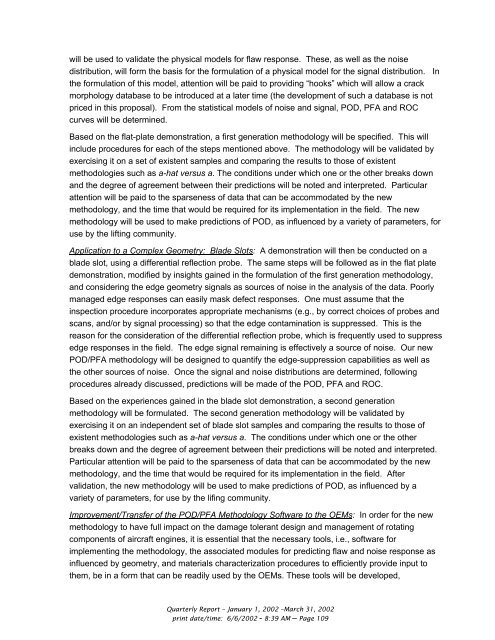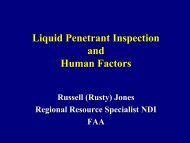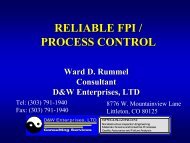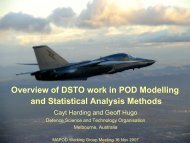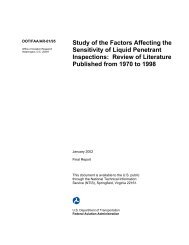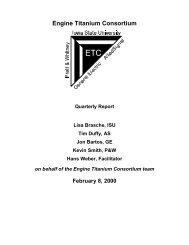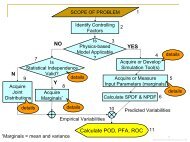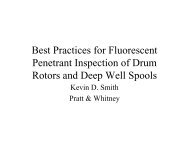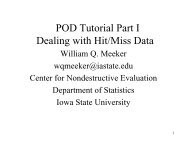Engine Titanium Consortium - Center for Nondestructive Evaluation ...
Engine Titanium Consortium - Center for Nondestructive Evaluation ...
Engine Titanium Consortium - Center for Nondestructive Evaluation ...
Create successful ePaper yourself
Turn your PDF publications into a flip-book with our unique Google optimized e-Paper software.
will be used to validate the physical models <strong>for</strong> flaw response. These, as well as the noise<br />
distribution, will <strong>for</strong>m the basis <strong>for</strong> the <strong>for</strong>mulation of a physical model <strong>for</strong> the signal distribution. In<br />
the <strong>for</strong>mulation of this model, attention will be paid to providing “hooks” which will allow a crack<br />
morphology database to be introduced at a later time (the development of such a database is not<br />
priced in this proposal). From the statistical models of noise and signal, POD, PFA and ROC<br />
curves will be determined.<br />
Based on the flat-plate demonstration, a first generation methodology will be specified. This will<br />
include procedures <strong>for</strong> each of the steps mentioned above. The methodology will be validated by<br />
exercising it on a set of existent samples and comparing the results to those of existent<br />
methodologies such as a-hat versus a. The conditions under which one or the other breaks down<br />
and the degree of agreement between their predictions will be noted and interpreted. Particular<br />
attention will be paid to the sparseness of data that can be accommodated by the new<br />
methodology, and the time that would be required <strong>for</strong> its implementation in the field. The new<br />
methodology will be used to make predictions of POD, as influenced by a variety of parameters, <strong>for</strong><br />
use by the lifting community.<br />
Application to a Complex Geometry: Blade Slots: A demonstration will then be conducted on a<br />
blade slot, using a differential reflection probe. The same steps will be followed as in the flat plate<br />
demonstration, modified by insights gained in the <strong>for</strong>mulation of the first generation methodology,<br />
and considering the edge geometry signals as sources of noise in the analysis of the data. Poorly<br />
managed edge responses can easily mask defect responses. One must assume that the<br />
inspection procedure incorporates appropriate mechanisms (e.g., by correct choices of probes and<br />
scans, and/or by signal processing) so that the edge contamination is suppressed. This is the<br />
reason <strong>for</strong> the consideration of the differential reflection probe, which is frequently used to suppress<br />
edge responses in the field. The edge signal remaining is effectively a source of noise. Our new<br />
POD/PFA methodology will be designed to quantify the edge-suppression capabilities as well as<br />
the other sources of noise. Once the signal and noise distributions are determined, following<br />
procedures already discussed, predictions will be made of the POD, PFA and ROC.<br />
Based on the experiences gained in the blade slot demonstration, a second generation<br />
methodology will be <strong>for</strong>mulated. The second generation methodology will be validated by<br />
exercising it on an independent set of blade slot samples and comparing the results to those of<br />
existent methodologies such as a-hat versus a. The conditions under which one or the other<br />
breaks down and the degree of agreement between their predictions will be noted and interpreted.<br />
Particular attention will be paid to the sparseness of data that can be accommodated by the new<br />
methodology, and the time that would be required <strong>for</strong> its implementation in the field. After<br />
validation, the new methodology will be used to make predictions of POD, as influenced by a<br />
variety of parameters, <strong>for</strong> use by the lifing community.<br />
Improvement/Transfer of the POD/PFA Methodology Software to the OEMs: In order <strong>for</strong> the new<br />
methodology to have full impact on the damage tolerant design and management of rotating<br />
components of aircraft engines, it is essential that the necessary tools, i.e., software <strong>for</strong><br />
implementing the methodology, the associated modules <strong>for</strong> predicting flaw and noise response as<br />
influenced by geometry, and materials characterization procedures to efficiently provide input to<br />
them, be in a <strong>for</strong>m that can be readily used by the OEMs. These tools will be developed,<br />
Quarterly Report – January 1, 2002 –March 31, 2002<br />
print date/time: 6/6/2002 - 8:39 AM – Page 109


